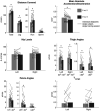Different Aspects of Physical Load in Small-Sided Field Hockey Games
- PMID: 37844190
- PMCID: PMC10798585
- DOI: 10.1519/JSC.0000000000004627
Different Aspects of Physical Load in Small-Sided Field Hockey Games
Abstract
Wilmes, E, de Ruiter, CJ, van Leeuwen, RR, Banning, LF, van der Laan, D, and Savelsbergh, GJP. Different aspects of physical load in small-sided field hockey games. J Strength Cond Res 38(2): e56-e61, 2024-Running volumes and acceleration/deceleration load are known to vary with different formats of small-sided games (SSGs) in field hockey. However, little is known about other aspects of the physical load. Therefore, the aim of this study was to gain a more thorough understanding of the total physical load in field hockey SSGs. To that end, 2 different SSGs (small: 5 vs. 5, ∼100 m 2 per player; large: 9 vs. 9, ∼200 m 2 per player) were performed by 16 female elite field hockey athletes. A range of external physical load metrics was obtained using a global navigational satellite system and 3 wearable inertial measurement units on the thighs and pelvis. These metrics included distances covered in different velocity ranges (walk, jog, run, and sprint), mean absolute acceleration/deceleration, Hip Load, and time spent in several physically demanding body postures. The effects of SSG format on these external physical load metrics were assessed using linear mixed models ( p < 0.05). Running volumes in various speed ranges were higher for the large SSG. By contrast, mean absolute acceleration/deceleration and time spent in several demanding body postures were higher for the small SSG. This study shows that changing the SSG format affects different aspects of physical load differently.
Copyright © 2023 The Author(s). Published by Wolters Kluwer Health, Inc. on behalf of the National Strength and Conditioning Association.
Figures



References
-
- Akenhead R, French D, Thompson KG, Hayes PR. The acceleration dependent validity and reliability of 10 Hz GPS. J Sci Med Sport 17: 562–566, 2014. - PubMed
-
- Bastiaansen BJC, Vegter RJK, Wilmes E, de Ruiter CJ, Lemmink KA, Brink MS. Biomechanical load quantification using a lower extremity inertial sensor setup during football specific activities. Sports Biomech 1–16, 2022. - PubMed
-
- Bates D, Sarkar D, Bates MD, et al. . The lme4 package. R Package Version 2: 74, 2007.
-
- Buchheit M, Haddad HA, Simpson BM, et al. . Monitoring accelerations with GPS in football: Time to slow down? Int J Sports Physiol Perform 9: 442–445, 2014. - PubMed
MeSH terms
LinkOut - more resources
Full Text Sources

